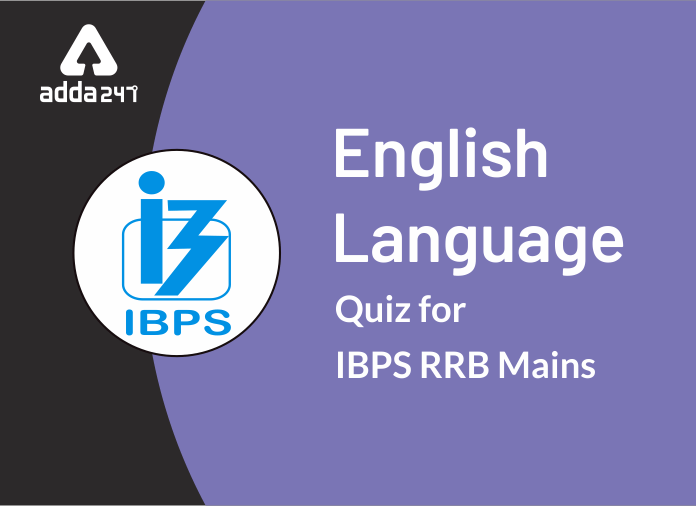IBPS RRB PO/Clerk Mains English Quiz
questions based on the given passage.
Reserve Bank of India (RBI) recently carried out its mandatory bi-monthly
announcement on the future course of monetary policy. These announcements
ostensibly offer ‘forward guidance’ to economic participants, so that they may
plan their future. Arguably, though, the public would have perhaps been more
interested in knowing how the RBI intends to respond to the unusually large
number of instances of fraud that have surfaced in the financial sector of
late. The RBI’s reputation as a regulator has been affected by these. What led
the bank to this place needs understanding.
banks command an important position in the market economies of the West today.
How in a democracy so much power could be ceded to an unelected body must
itself come as a surprise. It reflects two things: the political power of
financial interests in the U.S. economy and the global intellectual influence
of the American economic model. This model revolves around the goal of maximum
creation of wealth by private individuals unimpeded by societal objectives.
Leave alone the distribution of income, not even the objective of ensuring
stability of the economy is allowed to come in the way of private individuals
pursuing wealth enhancement.
regulation, which sets limits to private activity, is rejected as an
unnecessary interference in beneficial activity that maximises social gain, and
is therefore to be avoided. When applied to finance, this model requires of the
government only one action, namely, the control of inflation. Now, it is
difficult to see why anticipated inflation, being an increase in all prices at
the same rate, is harmful to production, the basis of an increase in wealth.
After all, when prices rise together, no one individual is worse off if the
inflation has been perfectly anticipated. It is unanticipated inflation that is
the problem for producers, as it has the potential to derail their profit
calculations. However, inflation, even when fully anticipated, can harm holders
of financial assets yielding fixed incomes by eroding their wealth.
on the other hand are better off with inflation as the real value of their
outstanding loans is now less. While the problem of inflation can in principle
be tackled through inflation-indexation, the practice is not widespread. This
leaves owners of financial wealth averse to inflation.
the volume of financial wealth in an economy increases so does the power of its
owners over government. Now inflation control tends to take centre-stage in
economic policy formulation. When
inflation control is implemented via monetary policy it results in higher
interest rates. Managers of financial wealth lobby for such a policy on behalf
of their clients. This lobbying is the origin of the policy of inflation
targeting. Inflation targeting by the central bank involves use of the interest
rate to keep inflation under control. As it targets inflation it must let go of
the employment objective. Though ‘flexible inflation-targeting’ is meant to
take care of this objection, inflation is retained as the target and the
central bank is not accountable for unemployment.
the introductory paragraph of the given passage?
The announcements provide a future direction to economic participants allowing
them to plan their future.
It helps the RBI carrying out bi-monthly monetary policy effectively.
RBI fails to monitor the announcements that are necessary for providing a gist
of monetary policy.
Both (b) and (c)
None of these
3
Reading Comprehension
Mishra
What are the factors that affect the reputation of RBI as a regulator?
It fails to address public grievances about large number of frauds having
surfaced in the financial sector.
It is unable to deal with the frequent fraudulent.
It cannot find it right direction on how to respond to large number frauds
occurring in financial sector.
Both (b) and (c)
None of these
3
Reading Comprehension
Mishra
ceded to an unelected body?
Financial interests’ political power in the economy of U.S.
American economic model influencing global intellectual.
Both (a) and (b)
Only (b)
None of these
3
Reading Comprehension
Mishra
What’s the action of government that is required when Public regulation is
applied to finance?
It should set limits to private activities.
It must reject unnecessary interference.
The government must focus on maximizing the social gains.
The government should take action in the direction of controlling inflation
None of these
3
Reading Comprehension
Mishra
on producers?
The unanticipated inflation possesses the potential of derailing the profit
calculations of producers.
It increases prices of commodities at the same rate.
Failing to anticipate inflation results into rise in prices.
Both (b) and (c)
None of these
3
Reading Comprehension
inflation?
to tackle inflation.
3
Reading Comprehension
Mishra
What is the result of implementation of inflation control through monetary
policy?
It enhances economy wealth
The power of financial wealth owners rule over government.
It results into higher interests rates.
Both (a) and (b)
None of these
3
Reading Comprehension
Mishra
How Central Bank performs inflation targeting in order to control the same?
It manages financial wealth on behalf of its clients.
It uses rate of inflation in order to target inflation and keep it under
control.
The method involves usage of lowered interest rates.
Both (a) and (c)
None of these
3
Reading Comprehension
Mishra
Which of the following words is most SIMILAR in meaning with OSTENSIBLY as highlighted in the given
passage?
Apparently
Praiseworthily
Proactively
Significantly
Necessarily
2
Synonym
Mishra
Which of the following words is most SIMILAR in meaning with INIMPEDED as highlighted in the given
passage?
Biased
Unconstrained
Course
Steadily
Tedious
2
Synonym
Mishra
following six sentences (A), (B), (C), (D), (E) and (F) in the proper sequence
to form a meaningful paragraph and then answer the questions given below.
complex one is on social security. Here, the intention is to provide universal
coverage.
government’s intention to move forward with the proposed four labour codes to
replace the 40-plus labour laws is a welcome development.
The easy one on wages has already been enacted.
Such as in case of movement from self-employmentto casual employment in micro
and small enterprises, and then to the organised sector, and vice versa.
challenge would be to provide sufficient resources.
considerable ingenuity would be required to design a seamless transition of
benefits.
employment in micro and small enterprises, and then to the organised sector,
and vice versa.’ as last statement, which of the following should be the firstsentence
after rearrangement?
(a) B
(b) D
(c) A
(d) F
(e) C
3
Sentence Rearrangement
Q12.Considering statement (D), ‘Such as in case of movement from
self-employment to casual employment in micro and small enterprises, and then
to the organised sector, and vice versa.’ as last statement, which of the
following should be the thirdsentence after rearrangement?
(a)B
(b)F
(c)D
(d)C
(e)A
L1Difficulty 3
Sentence Rearrangement
Q13.Considering statement (D), ‘Such as in case of movement from
self-employment to casual employment in micro and small enterprises, and then
to the organised sector, and vice versa.’ as last statement,which of the
following should be the fourthsentence after rearrangement?
(a) B
(b) E
(c) F
(d) C
(e) D
L1Difficulty 3
Sentence Rearrangement
employment in micro and small enterprises, and then to the organised sector,
and vice versa.’ as last statement, which of the following should be the fifthsentence
after rearrangement?
(a)A
(b)D
(c)C
(d)F
(e)G
3
Sentence Rearrangement
Q15.Considering statement (D), ‘Such as in case of movement from
self-employment to casual employment in micro and small enterprises, and then
to the organised sector, and vice versa.’ as last statement,which of the
following should be the secondsentence after rearrangement?
(a) C
(b) B
(c) A
(d) G
(e) E
L1Difficulty 3
Sentence Rearrangement
Ans. (a)
Referring to the introductory paragraph of the given passage, inference can be
drawn from the lines, ‘The Reserve Bank
of India (RBI) recently carried out its mandatory bi-monthly announcement on
the future course of monetary policy. These announcements ostensibly offer
‘forward guidance’ to economic participants, so that they may plan their
future.’ Hence, option (a) is the right answer choice that forward guidance is referred to the
announcements carried out by RBI that
provide a future coarse to economic participants enabling them to plan their
future.
Ans. (a)
Referring to the introductory paragraph of the given passage, inference can be
drawn from the lines, ‘. Arguably,
though, the public would have perhaps been more interested in knowing how the
RBI intends to respond to the unusually large number of instances of fraud that
have surfaced in the financial sector of late. The RBI’s reputation as a
regulator has been affected by these.’ Hence, option (a) is the right
answer choice justifying the factors responsible for affecting RBI’s reputation
as a regulator.
Ans. (c)
Referring to the second paragraph of the given passage, inference can be drawn
from the lines, ‘Central banks command an
important position in the market economies of the West today. How in a
democracy so much power could be ceded to an unelected body must itself come as
a surprise. It reflects two things: the political power of financial interests
in the U.S. economy and the global intellectual influence of the American
economic model.’ Hence, option (c) is the right answer choice as both
option (a) and (b) are clearly mentioning the conclusion which is drawn when
power is relinquished to an unelected body.
Referring to the third paragraph of the given passage, inference can be drawn
from the lines, ‘Public regulation, which
sets limits to private activity, is rejected as an unnecessary interference in
beneficial activity that maximises social gain, and is therefore to be avoided.
When applied to finance, this model requires of the government only one action,
namely, the control of inflation.’ Hence, option (d) is the most suitable answer
choice that clearly indicates the required action from the government’s end
i.,e control of inflation.
Ans. (a)
Referring to the third paragraph of the given passage, inference can be drawn
from the lines, ‘Now, it is difficult to
see why anticipated inflation, being an increase in all prices at the same
rate, is harmful to production, the basis of an increase in wealth. After all,
when prices rise together, no one individual is worse off if the inflation has
been perfectly anticipated. It is unanticipated inflation that is the problem
for producers, as it has the potential to derail their profit calculations’.Hence,
option (a) is the right answer choice is describes the impact of unanticipated
inflation on producers clearly as mentioned in the given passage.
Ans. (a)
Referring to the fourth paragraph of the given passage, inference can be drawn
from the lines, ‘Borrowers on the other
hand are better off with inflation as the real value of their outstanding loans
is now less. While the problem of inflation can in principle be tackled through
inflation-indexation, the practice is not widespread. This leaves owners of
financial wealth averse to inflation.’ Hence, option (a) is the right
answer choice. It describes that as the practice of inflation-indexation of not
widespread, it results into unfavourable conditions of inflation for financial
wealth owners.
Ans. (c)
Referring to the fifth paragraph of the given passage, inference can be drawn
from the lines, ‘As the volume of
financial wealth in an economy increases so does the power of its owners over
government. Now inflation control tends to take centre-stage in economic policy
formulation. When inflation control is implemented via monetary policy it
results in higher interest rates.’ Hence, option (c) is the right answer
choice, which suitably describes the result of implementing inflation control
via monetary policy, as mentioned in the given passage.
Ans. (b)
Referring to the fifth paragraph of the given passage, inference can be drawn
from the lines, ‘Managers of financial
wealth lobby for such a policy on behalf of their clients. This lobbying is the
origin of the policy of inflation targeting. Inflation targeting by the central
bank involves use of the interest rate to keep inflation under control.’ Hence,
option (b) is the right answer choice.
Ans. (a)
The term ‘ostensibly’ means ‘as appears or is stated to be true, though not
necessarily so; apparently.’
Ans. (b)
The term ‘unimpeded’ means ‘not obstructed or hindered.’
S11. Ans. (a)
labour codes to replace the 40-plus labour laws is a welcome development.
provide universal coverage.
seamless transition of benefits
Such as in case of movement from self-employmentto casual employment in micro
and small enterprises, and then to the organised sector, and vice versa.
labour codes to replace the 40-plus labour laws is a welcome development.
provide universal coverage.
seamless transition of benefits
Such as in case of movement from self-employmentto casual employment in micro
and small enterprises, and then to the organised sector, and vice versa.
Sol. (B)The government’s intention to move forward with the proposed four
labour codes to replace the 40-plus labour laws is a welcome development.
provide universal coverage.
seamless transition of benefits
Such as in case of movement from self-employmentto casual employment in micro
and small enterprises, and then to the organised sector, and vice versa.
Sol.
labour codes to replace the 40-plus labour laws is a welcome development.
provide universal coverage.
seamless transition of benefits
Such as in case of movement from self-employmentto casual employment in micro
and small enterprises, and then to the organised sector, and vice versa.
Sol. (B)The government’s intention to move forward with the proposed four
labour codes to replace the 40-plus labour laws is a welcome development.
provide universal coverage.
seamless transition of benefits
Such as in case of movement from self-employmentto casual employment in micro
and small enterprises, and then to the organised sector, and vice versa.



_1568720648831.png)

